Each element in the top half of the array ( A[  + 1 ] . . . A[ n ] ) has two credits. Upon copying, the array is full and
+ 1 ] . . . A[ n ] ) has two credits. Upon copying, the array is full and  elements store 2 credits each, so we use up those 2 *
elements store 2 credits each, so we use up those 2 *  credits to pay for copying. Upon inserting a new element, we store two
credits on it.
credits to pay for copying. Upon inserting a new element, we store two
credits on it.
 ( push
) = T( push ) + num_bought - num_used
( push
) = T( push ) + num_bought - num_used
 Suppose we copy n elements.
Suppose we copy n elements.
 ( push ) = ( n
+ 1 ) + 2 - ( 2 *
( push ) = ( n
+ 1 ) + 2 - ( 2 *  )
)
 = 3
= 3
 Suppose we copy 0 elements.
Suppose we copy 0 elements.
 ( push ) = 1 +
2 - 0
( push ) = 1 +
2 - 0
 = 3
= 3

 In
a sequence of n pushes, each takes amortized time in O( 1 ).
In
a sequence of n pushes, each takes amortized time in O( 1 ).
Alternatively, we could use the Potential Method :
 = (
number of elements in the 'top half' of the array ) * 2
= (
number of elements in the 'top half' of the array ) * 2
 = ( t -
= ( t -  - 1 ) * 2
- 1 ) * 2
e.g.
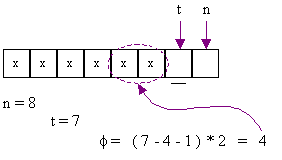
Suppose we copy n elements :


 ( 1 + n ) + ( 1 * 2 ) + (
( 1 + n ) + ( 1 * 2 ) + (  * 2 )
* 2 )

 3
3
Suppose we copy 0 elements :


 1 + [ ( ( t + 1 ) -
1 + [ ( ( t + 1 ) -  - 1 ) * 2 ] - [ ( t -
- 1 ) * 2 ] - [ ( t -  ) * 2 ]
) * 2 ]

 1 + 2
1 + 2
where the 2 represents 

 3
3
But let's not waste memory. If the stack shrinks dramatically, we should
free up some of the unused array space.
Idea
 When size shrinks to half the
capacity ( i.e. when t drops to
When size shrinks to half the
capacity ( i.e. when t drops to  + 1 ), shrink the capacity by half.
+ 1 ), shrink the capacity by half.
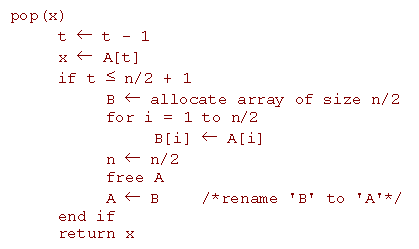
Problems
Push n times, where  .
.
| push once |
... expands ...
|
cost O( n ) |
| pop once |
... contracts ...
|
cost O( n ) |
| push once |
... expands ...
|
cost O( n ) |
| pop once |
... contracts ...
|
cost O( n ) |
| etc. |
|
|
There's no way the amortized cost can be O( 1 ).
Another Idea
When size shrinks to a quarter of the capacity ( i.e.
when  ) shrink
the array by half. Intuitively, we want many cheap operations before
an expensive one.
) shrink
the array by half. Intuitively, we want many cheap operations before
an expensive one.
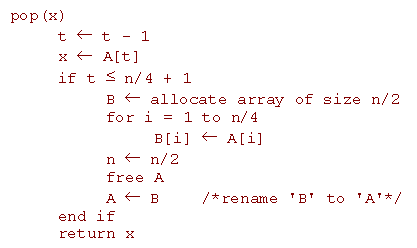

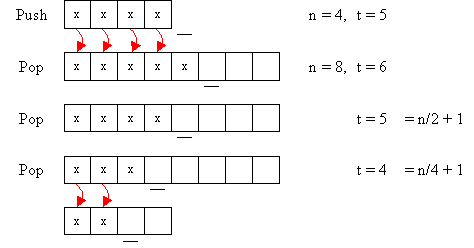
What pays for the copies?
We can't guarantee credits in A[  + 1 ] . . . A[ n ], since we might not have inserted anything there. On
the other hand, we know that, upon contracting, A[
+ 1 ] . . . A[ n ], since we might not have inserted anything there. On
the other hand, we know that, upon contracting, A[  + 1 ] ... A[ n ] used to have elements in them, which were popped.
+ 1 ] ... A[ n ] used to have elements in them, which were popped.
Idea
Upon popping, leave a credit behind in the now-empty slot of
A. When we contract, A[  + 1 ] ... A[
+ 1 ] ... A[  + 1 ] are guaranteed to contain
+ 1 ] are guaranteed to contain  + 1 credits, which will pay for copying
+ 1 credits, which will pay for copying  elements.
elements.
Note that A[  + 2 ] ... A[ n ] might have credits, but we can throw those away.
+ 2 ] ... A[ n ] might have credits, but we can throw those away.
So -
 ( push ) = T(
push ) + num_bought - num_used
( push ) = T(
push ) + num_bought - num_used
 suppose we don't
contact :
suppose we don't
contact :
 ( pop ) = cost
to return one + cost to put on A[ t ] - used
( pop ) = cost
to return one + cost to put on A[ t ] - used
 = 1 + 1 - 0 = 2
= 1 + 1 - 0 = 2
 suppose we contact
from n to
suppose we contact
from n to  and
copy
and
copy  elements
:
elements
:
 ( pop ) =
( pop ) =
 T( copy
T( copy  and return one )
and return one )
 + T( put on A[
+ T( put on A[  + 1 ] )
+ 1 ] )
 - ( credits in A[
- ( credits in A[  + 1 ] ... A[
+ 1 ] ... A[  + 1 ] )
+ 1 ] )
 = ( 1 +
= ( 1 +  ) + 1 - (
) + 1 - (  +
1 )
+
1 )
 = 1
= 1


 ( pop ) = 1
( pop ) = 1
This doesn't conflict with 'push', so -
 ( pop
)
( pop
)  O( 1 )
O( 1 )
 ( push )
( push )  O( 1 )
O( 1 )

 We
can maintain a dynamic stack in amortized constant time per operation!
We
can maintain a dynamic stack in amortized constant time per operation!
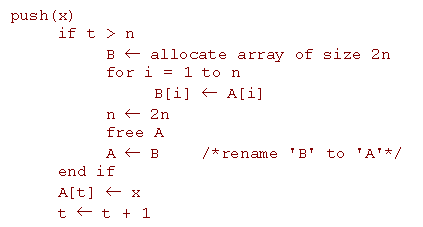
 ( push )
( push )  O( 1
)
O( 1
)
Let the elements already inserted pay for the copying :
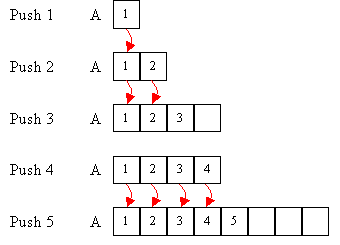
 + 1 ] . . . A[ n ] ) has two credits. Upon copying, the array is full and
+ 1 ] . . . A[ n ] ) has two credits. Upon copying, the array is full and  elements store 2 credits each, so we use up those 2 *
elements store 2 credits each, so we use up those 2 *  credits to pay for copying. Upon inserting a new element, we store two
credits on it.
credits to pay for copying. Upon inserting a new element, we store two
credits on it.
 ( push
) = T( push ) + num_bought - num_used
( push
) = T( push ) + num_bought - num_used
 ( push ) = ( n
+ 1 ) + 2 - ( 2 *
( push ) = ( n
+ 1 ) + 2 - ( 2 *  )
)
 ( push ) = 1 +
2 - 0
( push ) = 1 +
2 - 0
 = (
number of elements in the 'top half' of the array ) * 2
= (
number of elements in the 'top half' of the array ) * 2
 - 1 ) * 2
- 1 ) * 2


 ( 1 + n ) + ( 1 * 2 ) + (
( 1 + n ) + ( 1 * 2 ) + (  * 2 )
* 2 )
 3
3
 1 + [ ( ( t + 1 ) -
1 + [ ( ( t + 1 ) -  - 1 ) * 2 ] - [ ( t -
- 1 ) * 2 ] - [ ( t -  ) * 2 ]
) * 2 ]
 1 + 2
1 + 2
 3
3 + 1 ), shrink the capacity by half.
+ 1 ), shrink the capacity by half.

 .
.
 ) shrink
the array by half. Intuitively, we want many cheap operations before
an expensive one.
) shrink
the array by half. Intuitively, we want many cheap operations before
an expensive one.


 + 1 ] . . . A[ n ], since we might not have inserted anything there. On
the other hand, we know that, upon contracting, A[
+ 1 ] . . . A[ n ], since we might not have inserted anything there. On
the other hand, we know that, upon contracting, A[  + 1 ] ... A[ n ] used to have elements in them, which were popped.
+ 1 ] ... A[ n ] used to have elements in them, which were popped.
 + 1 ] ... A[
+ 1 ] ... A[  + 1 ] are guaranteed to contain
+ 1 ] are guaranteed to contain  + 1 credits, which will pay for copying
+ 1 credits, which will pay for copying  elements.
elements.
 + 2 ] ... A[ n ] might have credits, but we can throw those away.
+ 2 ] ... A[ n ] might have credits, but we can throw those away. ( push ) = T(
push ) + num_bought - num_used
( push ) = T(
push ) + num_bought - num_used
 suppose we don't
contact :
suppose we don't
contact :
 ( pop ) = cost
to return one + cost to put on A[ t ] - used
( pop ) = cost
to return one + cost to put on A[ t ] - used
 suppose we contact
from n to
suppose we contact
from n to  and
copy
and
copy  elements
:
elements
:
 ( pop ) =
( pop ) =
 and return one )
and return one )
 + 1 ] )
+ 1 ] )
 + 1 ] ... A[
+ 1 ] ... A[  + 1 ] )
+ 1 ] )
 ) + 1 - (
) + 1 - (  +
1 )
+
1 )
 ( pop ) = 1
( pop ) = 1
 ( pop
)
( pop
)  O( 1 )
O( 1 )
 ( push )
( push )  O( 1 )
O( 1 ) = max(
2( t -
= max(
2( t -  - 1
),
- 1
),  + 2 - t
)
+ 2 - t
)